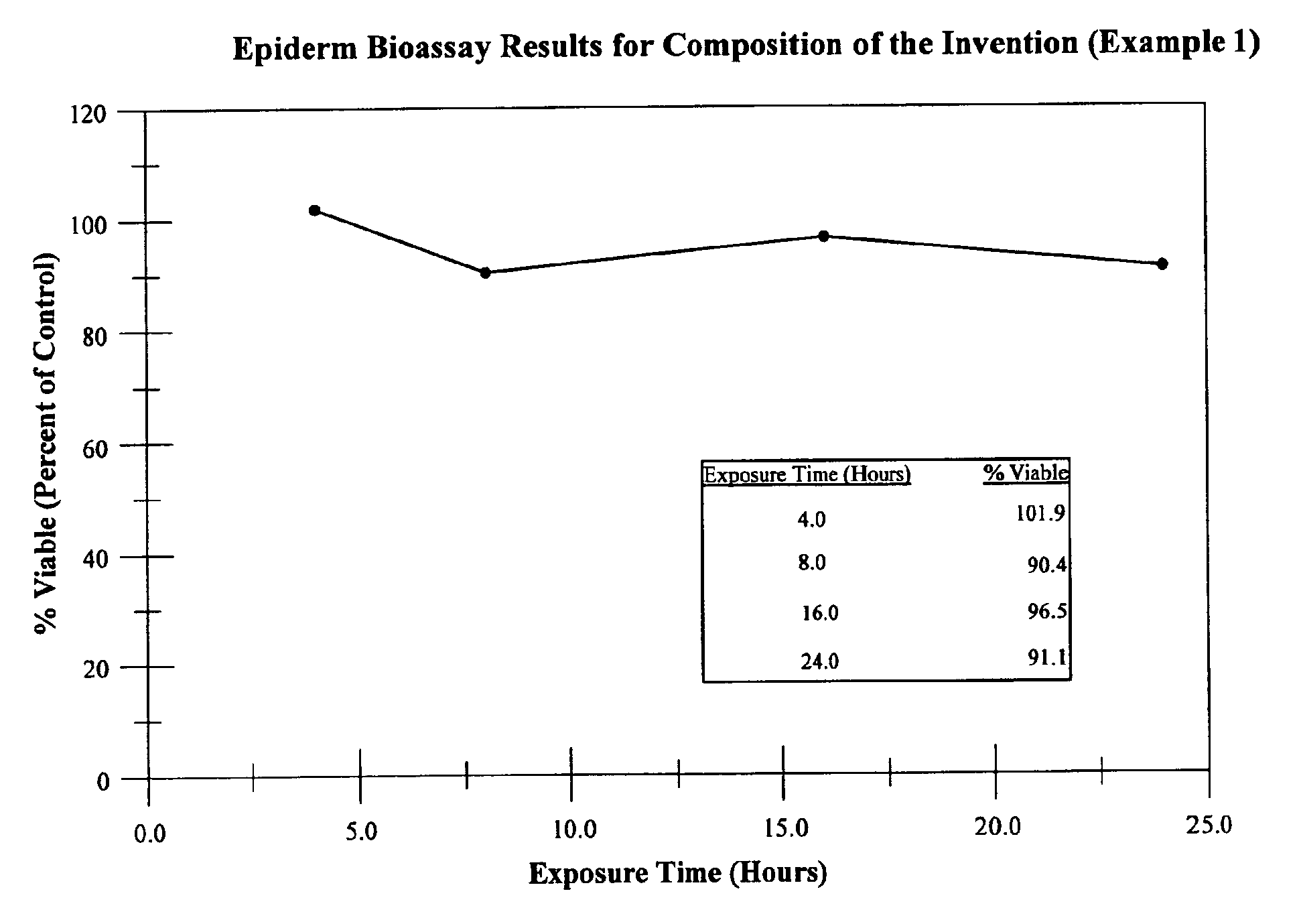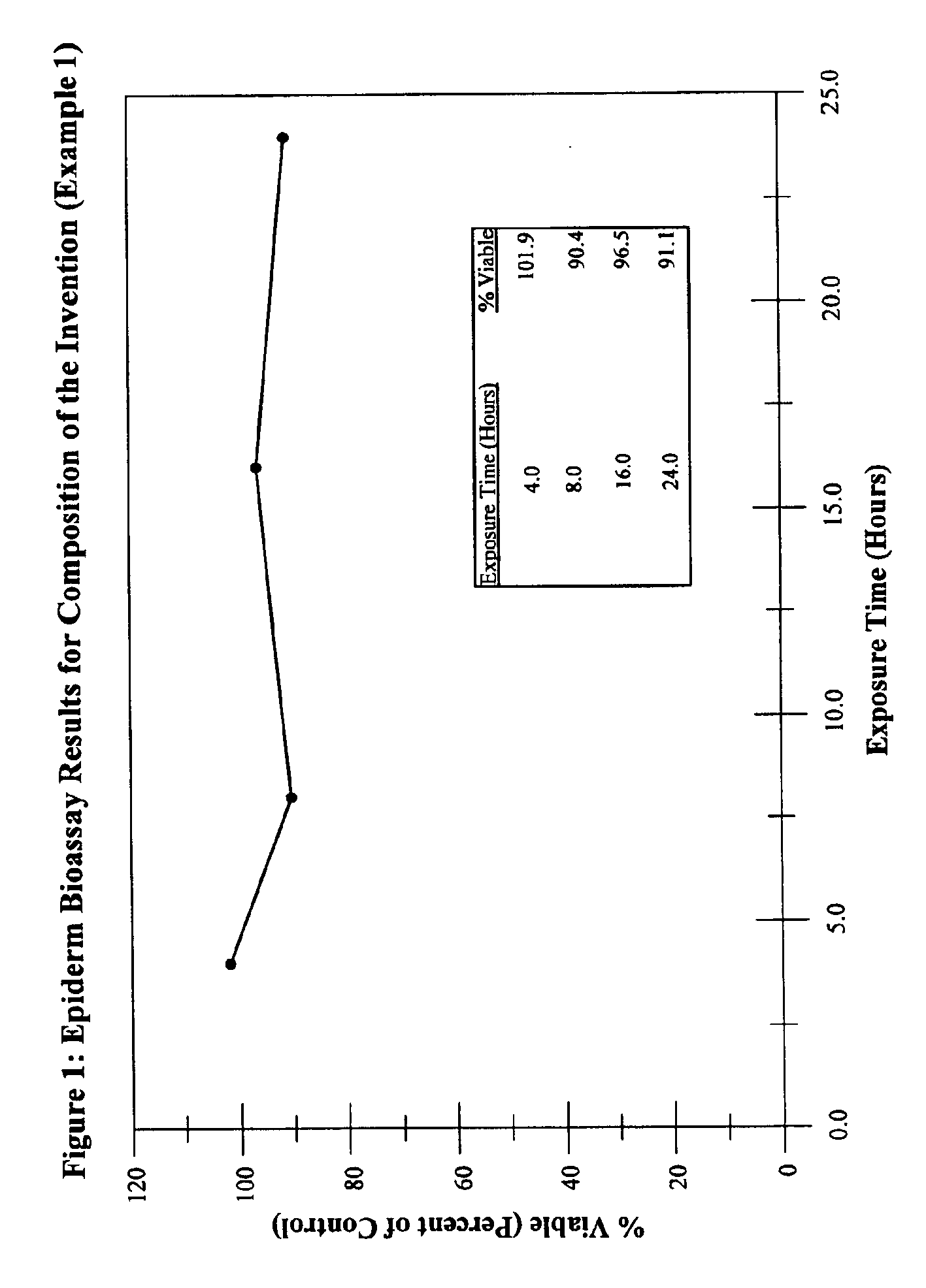Warming and nonirritating lubricant compositions and method of comparing irritation
- Summary
- Abstract
- Description
- Claims
- Application Information
AI Technical Summary
Benefits of technology
Problems solved by technology
Method used
Image
Examples
example 1
EpiDerm™ Skin Model Assay to Test Irritation of Lubricants
[0048]The method designated as EpiDerm™ Skin Model assay uses the epithelial cells derived from human skin as target cells and is commercially available from the MatTek Corporation. This assay is described in Berridge, M. V., et al. (1996) The Biochemical and Cellular Basis of Cell Proliferation Assays That Use Tetrazolium Salts. Biochemica 4: 14-19. The test materials are applied directly to the epithelial cell culture surface. This test has not previously been used for determining toxicity of test materials. The toxicity of the test material is evaluated on the basis of relative tissue viability vs time. The actual Tissue Viability is determined by NAD(P)H-dependent microsomal enzyme reduction of MTT in control and test article treated cultures. The negative control used in this assay was deionized water and the positive control was Triton X-100. The exposed cell cultures were incubated for 4, 8, 16 and 24 hours and assayed...
example 2
Generation of Warmth
[0051]The compositions of this invention are anhydrous and contain one or more polyhydric alcohol. When combined with water, the polyhydric alcohols used in the compositions of this invention generate an increase in temperature that has a soothing effect on the tissues these compositions are applied. In actual use the compositions of the invention interact with the moisture of the vaginal or oral mucosa, thereby increasing the temperature or generating feeling of warmth.
[0052]The “Generation of warmth” data summarized in Table 1 below, was generated by mixing 20 ml of each of the ingredients in Composition 1 and Composition 1 of this invention with 20 ml of water. The temperature of the product and that of water were recorded before water was added to the product. After the addition of water the mixture was mixed for two minutes and the actual temperature was recorded. Glycerin, Propylene Glycol and Honey are the ingredients in Composition 1. It is clear from Tab...
example 3
Effect of Water Content on Generation of Warmth
[0055]On contact with moisture or water the heat of solution is responsible for the warming action of the compositions of this invention. There is a concern that accidental contamination with water or prolonged exposure to excessive moisture, the warming capacity of the product may be adversely effected. According to this example, water was added to compositions of this invention varying from about 1% to about 10% as outlined in Table 2 below. The contents were thoroughly mixed and the samples were allowed to stay at room temperature for 24 hour following which the generation of warmth was determined as outlined in the following paragraph. The results show that rise in temperature is proportionately decreased depending on the quantity of water added but there is still an 8.5° F. increase in temperature at about 10% water addition.
[0056]The results of this example are set forth in Table 2 below.
[0057]
TABLE 2Effect Of Water Content On Gen...
PUM
| Property | Measurement | Unit |
|---|---|---|
| Fraction | aaaaa | aaaaa |
| Fraction | aaaaa | aaaaa |
| Percent by mass | aaaaa | aaaaa |
Abstract
Description
Claims
Application Information
 Login to View More
Login to View More - R&D
- Intellectual Property
- Life Sciences
- Materials
- Tech Scout
- Unparalleled Data Quality
- Higher Quality Content
- 60% Fewer Hallucinations
Browse by: Latest US Patents, China's latest patents, Technical Efficacy Thesaurus, Application Domain, Technology Topic, Popular Technical Reports.
© 2025 PatSnap. All rights reserved.Legal|Privacy policy|Modern Slavery Act Transparency Statement|Sitemap|About US| Contact US: help@patsnap.com



